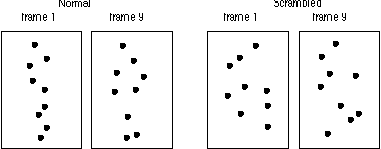
One very compelling example of the visual system's ability to recover object information from sparse input is the phenomenon known as biological motion. Here the activity and identity of an animate creature are compellingly created using just a dozen or so "light points" strategically placed on the individual's body (Johansson 1973). With these animation sequences, no single dot conveys information about the object or event being depicted - individual dots merely undergo translational and/or elliptical motions. Perception of a biological organism engaged in an activity must entail global integration of these motion signals over space and time - perception of such animation sequences is literally the creation of motion information (in the same sense that perception of an object in a random-dot stereogram is the creation of binocular disparity information). When viewing point-light displays, observers can identify the gender of an actor (eg, Kozlowski & Cutting 1977; Mather & Murdoch 1994), the activity in which he/she is engaged (Johansson 1973) and, even, the emotional state of the actor (eg, Brownlow et al 1997). Human infants as young as 3 months of age can perceive biological motion (eg, Fox & McDaniel 1982), as can non-human mammals (Blake 1993).
We have developed computer-based techniques for creating biological motion sequences as well as novel psychophysical and brain imaging procedures for examining biological motion perception. We record an individual (or group of individuals) engaged in an activity, transcribe those recordings to the computer, place tokens on the joints of each frame of the movie sequence and then convert those frames to matrices that can be animated and manipulated in MatLab©. Shown below are two frames (not successive in the animation) from a "normal" biological sequence (in this case, the actor is throwing an object) and two frames (nonsuccessive) from a phase-scrambled sequence created from the "throwing" animation. The phase scrambled animations consist of the same individual dots undergoing the same local motions, only with their temporal phases scrambled -- this perturbs the hierarchical, pendular motions characteristic of biological motion.

Animations showing normal and phase-scrambled sequences can be seen here:
|
|
|
|
|
|
Activity portrayed by "point-light" sequences can be seen even when the "actor" appears within a snowstorm of noise dots:
|
|
Blake R (1993) Cats perceive biological motion. Psychological Science 4, 54-57.
Ahlstrom V, Blake R & Ahlstrom U (1997) Perception of biological motion. Perception, 26, 1539-1548.
Grossman E & Blake R (1999) Perception of coherent motion, biological motion and form-from-motion under dim-light conditions. Vision Research, 39, 3721-3727.
Grossman E, Donnelly M, Price R, Morgan V, Pickens D, Neighbor G & Blake R (2000) Brain areas involved in perception of biological motion. Journal of Cognitive Neuroscience, 12, 711-720.
Grossman, E. & Blake, R. (2001) Brain activity evoked by inverted and imagined biological motion. Vision Research, 41, 1475-1482.
Tadin, D., Lappin, J.S., Blake, R. & Grossman, E. (2002) What constitutes an efficient reference frame for vision? Nature Neuroscience, 5, 1010-1015.
Grossman, E. & Blake, R. (2002) Brain areas active during visual perception of biological motion. Neuron, 35,1167-1176.
Blake, R., Turner, L.M., Smoski, M.J., Pozdol, S.L. & Stone, W.L. (2003) Visual recognition of biological motion is impaired in children with autism. Psychological Science, 14, 151-157.
Grossman, E., Blake, R. & Kim, C.-Y. (2004) Learning to see biological motion: brain activity parallels behavior. Journal of Cognitive Neuroscience, 16, 1669-1679.
Ikeda, H., Blake, R. & Watanabe, K. (2004) Hemispheric bias in perception of biological motion. Vision, 16, 235-238.
Ikeda, H., Blake, R. & Watanabe, K. (2005) Eccentric perception of biological motion is unscalably poor. Vision Research.45, 1935-1943.
Kim, J., Doop, M.L., Blake, R. and Park, S. (2005) Impaired visual recognition of biological motion in schizophrenia. Schizophrenia Research, 77, 299-307.
Freire, A., Lewis, T.L., Maurer, D. & Blake, R. (2006) The development of sensitivity to biological motioin in noise. Perception, 35, 647-657.
Blake, R. & Shiffrar, M. (2007) Perception of human motion. Annual Review of Psychology, 58, 47-73.